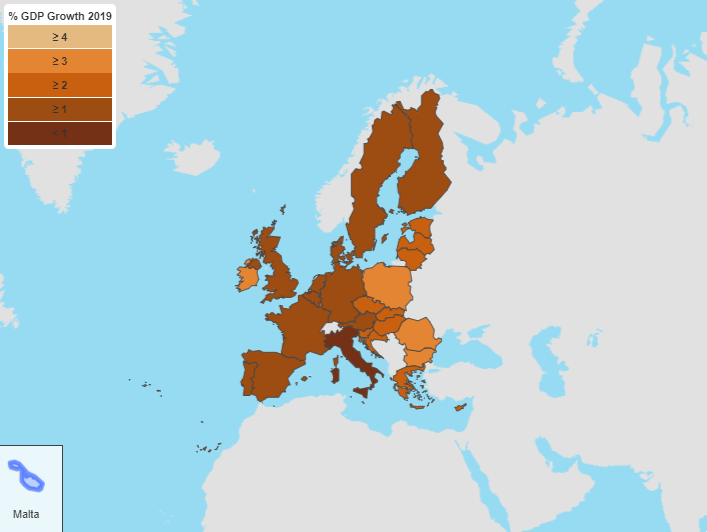Evropska komisija v svoji Jesenski napovedi za 2019 izpostavlja tveganja povezana s svetovno trgovinsko politiko. Ta bi lahko ob nadaljnjem zaostrovanju močno vplivala na poslovanje evropskih podjetij in njihovih investicijskih horizontov.
Even though the EU economy is already affected by plenty of external headwinds, there is still a meaningful number of risks that have not yet been materialized. What is yet under development and could be materialized are the US-China trade tensions, US tariffs on car imports, an economic slowdown in China and geopolitical tensions in the Middle East. In addition, the EU also faces an internal headwind with the never-ending Brexit, which could dampen the economic growth if exercised in a »disordered« form.
Additionally, trade tensions could lead to further tariff hikes which would force enterprises to reshape and diversify their global value chains in order to mitigate risk. Consequently, the global economy could become less interdependent and less integrated. A further slowdown or even a possible reversal of global value chain trade could be expected in the near future.
What about the big players?
- Germany is expected to see muted growth even though it slipped into a technical recession in mid-2019. Foreign demand will likely be weaker than previously expected and domestic demand is set to be dampened by weak investments.
- France’s real GDP growth is set to decrease in 2019 before leveling with the economy’s potential. The slowdown is expected in investments which will be partly compensated by a rise in private consumption.
- In The Netherlands, the growth is forecast to moderate as the business cycle matures. Expansionary fiscal policy is set to boost disposable income and public consumption.
- Italy still shows no recovery after its economy being stalled at the beginning of 2018. Growth is set to pick up modestly in 2020 on the back of rising external demand and moderate household spending.
Map of expected 2019 GDP growth for EU countries

Picture: European Commission, Autumn 2019 Economic Forecast
We can observe that the highest expected GDP growth – greater or equal to 4%, is expected in Poland, Romania, and Bulgaria. Central Europe, aside from Poland, and Eastern Europe are expected to have a growth of approximately 3 – 4%. Western Europe will have an expected growth between 2 and 3%. Among the Southern European countries, which are expected to have a GDP growth between 2% and 3%.The worst-performing EU country is expected to be Italy with an expected GDP growth lower than 1%.
The full Autumn 2019 Economic Forecast report is available here
This article summary was written by Aljaž, Risk manager at Alpha Credo.
